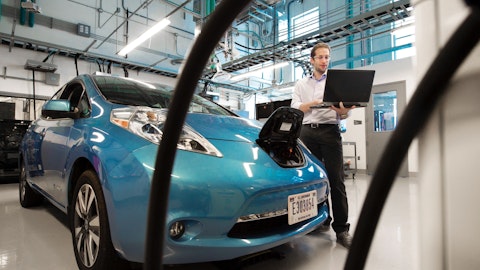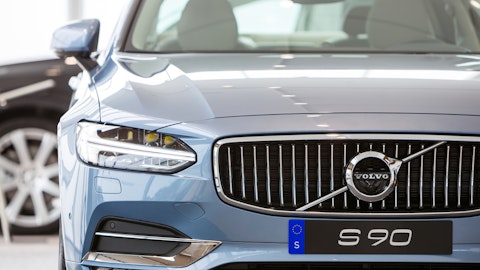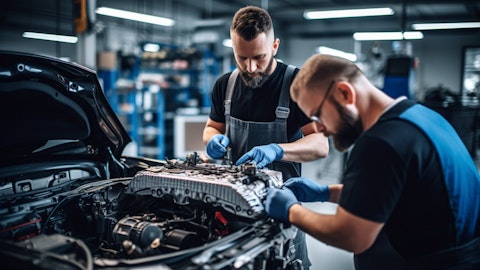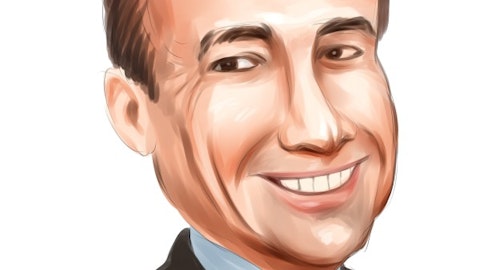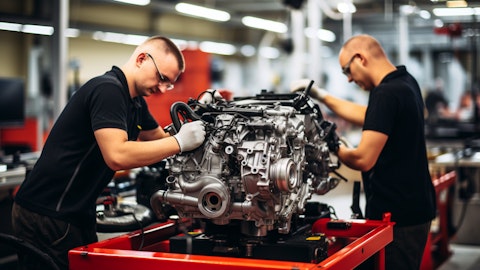BorgWarner Inc. (NYSE:BWA) Q4 2023 Earnings Call Transcript February 8, 2024
BorgWarner Inc. misses on earnings expectations. Reported EPS is $0.9 EPS, expectations were $0.93. BWA isn’t one of the 30 most popular stocks among hedge funds at the end of the third quarter (see the details here).
Operator: Good morning. My name is Savannah, and I will be your conference facilitator. At this time, I would like to welcome everyone to the BorgWarner 2023 Fourth Quarter and Full Year Financial Results Call. All lines have been placed on mute to prevent any background noise, and after the speakers’ remarks there will be a question-and-answer period. [Operator Instructions] I would now like to turn the conference over to Patrick Nolan, Vice President of Investor Relations. Mr. Nolan, you may begin your conference.
Patrick Nolan: Thank you, Savannah. Good morning, everyone, and thank you for joining us today. We issued our earnings release earlier this morning. It’s posted on our website, borgwarner.com, both on our home page and our Investor Relations home page. With regard to our Investor Relations calendar, we will be attending multiple conferences between now and our next earnings release. Please see the Events section of our IR page for a full list. Before we begin I need to inform you that during this call, we may make forward-looking statements, which involve risks and uncertainties and details in our 10-K. Our actual results may differ significantly from the matters discussed today. During today’s presentation, we will highlight certain non-GAAP measures in order to provide a clearer picture of how the core business performed and for comparison purposes with prior periods.
When you hear us say on a comparable basis, that means excluding the impact of FX, net M&A and other non-comparable items. When you hear us say adjusted that means excluding non-comparable items. And finally, when you hear us say organic, that means excluding the impact of FX and net M&A. We will also refer to our growth compared to our market. When you hear us say market that means the change in light and commercial vehicle production weighted for our geographic exposure. Please note that we’ve posted today’s earnings call presentation to the IR page of our website. We encourage you to follow along with these slides during our discussion. With that, I’m happy to turn the call over to Fred.
Fred Lissalde: Thank you, Pat, and good day, everyone. We’re pleased to share our results for 2023 and provide an overall company update, starting on Slide 5. With approximately $14 billion in sales, we delivered more than 12% organic growth in 2023. Our margin performance was strong, coming at the high end of our guide. During the course of ’23, we adjusted our eProducts top line to reflect what we saw in the marketplace. It resulted in a slightly lower top line for the Company but higher margins. This is a good example of the product portfolio resilience that exists at BorgWarner. We delivered $565 million of free cash flow in 2023. This free cash flow supported the $177 million of share repurchases that we executed during the fourth quarter as well as the closing of the Eldor acquisition.
Our challenging forward progress continues on multiple fronts. We secured multiple new eProduct awards during the fourth quarter, adding to the already announced over the course of the year. These awards were across our portfolio for both BEV and hybrid architectures. We continue to see a strong sourcing pool for our products based on the strength of our portfolio globally. Lastly, we took steps to enable new business awards by executing several strategic actions to further strengthen our eProduct portfolio, like the acquisition of Eldor Electronics business as well as the strategic agreement with BYD, FinDreams Battery for LFP packs outside of China. Now let’s look at some new eProduct awards on Slide 6. First, BorgWarner has been selected by XPeng to supply its eMotor rotor and stator for the X9 MPV as well as for their next electric B-class sedan.
Production began in January 2024 for the X9 and we’re planning to start producing for the B-class sedan in Q3 ’24. Our high-voltage hairpin 220E motor offers high power and torque density and higher efficiency at a competitive cost. We’re excited to supply XPeng with our proven stator on rotor as we believe it continues to position us for long-term success in China, where NEV penetration is already more than 35% of the market. Second, BorgWarner has secured in the world with a major global OEM to extend its existing business, supplying 400-volt high-voltage coolant heaters for some of the automakers light vehicle based platforms, specifically for its passenger truck and SUV programs. This business win is one of the three awards with North American OEMs incorporating BorgWarner’s high-voltage cooler and heaters into their vehicles.
Third, BorgWarner has secured in the world with a major Chinese OEM to supply its 90-kilowatt dual inverter on a series of the automaker’s plug-in hybrids and range extended electric vehicles. Production is expected to begin in September this year. The dual inverter is developed for hybrid vehicles as an integrated solution. The product utilizes BorgWarner’s Viper power module platform and leverages our inverter product leadership and scale. Next, on Slide 7. In addition to securing new business, we took multiple steps to build additional capabilities within our eProduct portfolio, driving product leadership and differentiation. I would like to highlight three of them today. First, BorgWarner completed its acquisition of the electric hybrid systems segment of Eldor.
This provides us with additional capabilities in onboard chargers, DC/DC converters and integrated high-voltage boxes, all of which are expected to complement BorgWarner’s existing product portfolio in hybrids and BEV. Next, BorgWarner is continuing to expand its product portfolio for battery electric and hybrid commercial vehicles through our agreement to form a joint venture with Shaanxi Fast Auto Drive Group, a Weichai subsidiary. We’re working together to accelerate the product efficiency and growth in the Chinese CV market with the largest CV powertrain supplier in China. BorgWarner will then be able to use these products and technologies for the rest of the world. Finally, BorgWarner signed an international strategic relationship agreement with BYD subsidiary, FinDreams Battery for LFP sales and tax.
Under this agreement, BorgWarner will be the only non-OEM localized manufacturer unaffiliated with FinDreams Battery with rights to localize LFP battery packs for commercial vehicles, utilizing FinDreams Battery blade cells. These packs are expected to be sold in the CV market in Europe, the Americas and select Asia Pacific regions. The LFP battery chemistry is an exciting technology that is cost competitive in comparison with some other cell chemistries. We’re seeing increased demand from our customers for tax with LFP sales. FinDreams Battery is right for BorgWarner in this area with over 20 years of experience in batteries with numerous successful product launches. Next, on Slide 8, I would like to summarize the growth we expect in our eProduct sales in 2024.
We expect 2024 eProduct sales of $2.5 billion to $2.8 billion, representing a year-over-year growth of 25% to 40%. One important driver of our 2024 growth is expected to be our battery system product line. Battery Systems demand from our commercial vehicle customers, trucks and buses continues to outpace our ability to produce. However, we are continuing to increase our capacity to meet this strong customer demand, both in Seneca, North Carolina; and in Europe. We expect this capacity expansion to help drive a $250 million to $350 million increase in battery systems sales in 2024, which equates to 55% to 75% year-over-year growth with more to come. Then looking at the other parts of our eProduct portfolio, our guidance assumes 14% to 27% year-over-year growth, with the mid-point roughly in line with our expected BEV hybrid market growth.
Overall, we expect 2024 to be a heavy year related to the number of launches across our light vehicle portfolio from iDM to motors from power electronics to thermal management globally for both BEVs and hybrids. While we expect another year of volatility in BEV and hybrids volume for the industry, we believe our capacity expansions and intense launch activities will support our outlook. Finally, on Slide 10. I want to take the opportunity to remind you of the intent of Charging Forward 2027. Charging Forward 2027 has three pillars; one, eProducts growth; two, eProduct profitability; and three, maximize the foundational value. The first two pillars centered around supporting BorgWarner’s long-term profitable growth. We continue to believe that despite near-term volatility, the mid- to long-term trends towards electrification, BEV and hybrids remain strong.
We believe that BorgWarner clearly positioning itself to be among the leaders in terms of eProduct business awards and to do so profitably. The third pillar of Charging Forward is an enabler of this long-term growth. Our foundational business brings customer relationship, technology capabilities and the ability to internally fund our investments. As importantly, with this leading market positions and strong margin profile, we believe our foundational business provides near-term earnings resiliency during times of BEV and hybrid market volatility just as we highlighted at our Investor Day back in June. As Kevin will review, that is evident both in our 2023 results and our 2024 outlook. The key takeaway is that both our eProducts and our foundational business lines play important role in Charging Forward 2027.
This was true when we unveiled our plan in June and it remains true today. As I look back on 2023, my take is this: BorgWarner successfully managed another challenging environment during 2023. We delivered solid margins and strong free cash flow which is a sign of the product resiliency that we built. We successfully completed the spin-off of PHINIA. We secured new business awards that are supportive of our long-term revenue objectives in all types of electrification, powertrain architectures. We also secured some critical alliances, especially on the CV side with subsidiaries of Weichai for inverters and BYD for battery packs. We also continued to return capital to shareholders. BorgWarner has repurchased about 600 million of stock since completing the Delphi acquisition in 2020.
And over the last four years, we have also returned about 600 million to shareholders in dividends. So BorgWarner has returned about $1.2 billion to shareholders since 2020 and that’s before considering the tax-free spin-off PHINIA. Moving into 2024 and beyond. We are balancing near-term margins relative to our long-term objectives. We expect to manage our incremental margin holistically, while continuing to invest in our future growth. As we’ve always said, the industry growth in BEV and hybrids will not be a straight line. The near-term volatility is a long-term opportunity for the companies with the final strength, earnings resiliency, and the great product leadership focus, that BorgWarner processes. Our product portfolio is built for resiliency such that a longer combustion tail will help margin and cash generation.
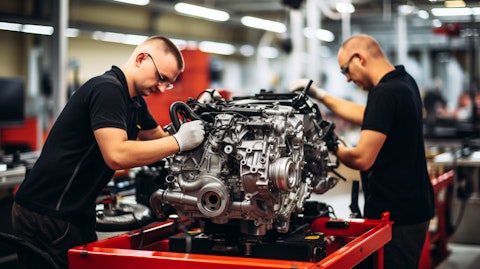
As a company, we are executing our Charging Forward 2027, which we expect will deliver value to our shareholders here and now and long into the future. This is Kevin’s last earnings call with the Company, and I wanted to take a moment to personally thank him for his tremendous contribution to our company over the past years. Kevin has played an instrumental role in all of BorgWarner’s recent major strategic initiatives ranging from the acquisition of Delphi to the creation and execution of Charging Forward as well as the spin-off of PHINIA. On behalf of the entire Board of Directors and the management team, I thank him for his contribution to our company, for his friendship and wish him a fantastic retirement. I look forward to Craig Aaron’s stepping into the CFO role next month.
I am confident Craig has the right skills, the deep knowledge of BorgWarner and our industry to execute our next chapter of profitable growth. With that, let me turn the call over to Kevin.
Kevin Nowlan: Thank you, Fred, and good morning, everyone. Before I dive into the financials, I’d like to provide a quick overview of our fourth quarter results. First, revenue was at the midpoint of our guidance, supported by stronger-than-expected industry production in the quarter. Second, our margin performance was at the high end of our guidance, driven by strong conversion on higher revenue. And finally, we delivered strong free cash flow performance to finish out the year. Let’s turn to Slide 10 for a look at our year-over-year revenue walk for Q4. Last year’s Q4 revenue from continuing operations was just over $3.3 billion. You can see that the weakening U.S. dollar drove a year-over-year increase in revenue of almost 2% or $55 million.
Then you can see the increase in our organic revenue, which was roughly 4.5% year-over-year. The reason why our growth wasn’t stronger is that we were negatively impacted in the quarter by customer launch and ramp up the BEVs key eProduct programs in China, lower customer volumes on a North American EV program and lost sales due to the UAW strike in North America. Finally, the acquisitions of Eldor and SSE added $5 million to revenue year-over-year. The sum of all this was just over $3.5 billion of revenue in Q4. Turning to Slide 11. You can see our earnings and cash flow performance for the quarter. Our fourth quarter adjusted operating income was $332 million, equating to a 9.4% margin. That compares to adjusted operating income from continuing operations of $321 million or 9.7% from a year ago.
On a comparable basis, excluding the impact of foreign exchange and the impact of M&A, adjusted operating income increased $16 million on $145 million of higher sales. This performance includes a planned eProduct-related R&D increase of $15 million. Excluding this higher R&D investment, we converted an approximately 21% on the organic sales increase. Our adjusted EPS from continuing operations was down $0.04 compared to a year ago as higher adjusted operating income was offset by a higher effective tax rate. Recall that our adjusted effective tax rate in Q4 of 2022 was only 18% lower than our typical tax rate. And finally, free cash flow from continuing operations was $679 million during the fourth quarter, which allowed us to deliver full year free cash flow of $565 million.
On Slide 12, I’d like to take a moment to look at our 2023 results compared to the post-PHINIA spin-off guidance that we provided in June, because I think it provides a helpful look at the resilience we believe underlies our current product portfolio. You’ll see that overall sales came in modestly below the midpoint of that guidance. While product sales fell short by about $400 million relative to the midpoint of our $2.3 billion to $2.6 billion guide, foundational sales largely offset this coming in about $300 million higher than the June guidance. However, the real evidence of our earnings resilience is in our adjusted operating margin performance. Despite the shortfall in sales relative to the midpoint of our June guidance, adjusted operating margin and adjusted operating income dollars came in above the midpoint of that June guidance.
This demonstrates precisely the resiliency we’ve been speaking about since our Investor Day. If the products are weaker, then our revenue isn’t going to grow as quickly, but our margin is likely going to be stronger, and that’s what happened in the second half of 2023. Let’s now turn to Slide 13. You can see our perspective on global industry production for 2024. We expect our global weighted light and commercial vehicle markets to be flat to down 2.5% this year. Looking at this by region, we’re planning for our weighted North American markets to be down 1% to up 1%. In Europe, we expect our blended market to be down 2% to 4% year-over-year. And in China, we expect the overall market to be down 1% to up 1%. Now let’s take a look at our full year outlook on Slide 14.
First, it’s important to note that our guidance assumes minimal impact from foreign currencies on full year sales. Second, as I previously mentioned, we expect our markets to be flat to down 2.5% for the year. Despite that, we expect to continue to deliver year-over-year organic sales growth, driven by growth in our product sales. Specifically, in 2024, we’re expecting to deliver between $2.5 billion and $2.8 billion in eProduct sales, which is up significantly from the approximately $2 billion we generated in 2023. Finally, the Eldor acquisition is expected to add approximately $40 million to 2024 revenue. Based on these expectations, we’re projecting total 2024 revenue in the range of $14.4 billion to $14.9 billion, which equates to organic growth of approximately 1% to 5%.
Let’s switch to margin. We expect our full year adjusted operating margin to be in the range of 9.2% to 9.6%. It’s important to note that this guidance includes a negative operating income impact due to the Eldor acquisition. With Eldor, we purchased strong engineering capabilities that we believe more clearly puts us on the path to achieving product leadership in an addressable market that we expect will approach $30 billion by 2030. However, that business has very little revenue today, which means we’ll be generating operating losses for the next few years. Excluding the impact of those Eldor related losses in 2024, we expect adjusted operating margin to be in the range of 9.6% to 9.9%, which compares to our 2023 margin of 9.6%. That implies the rest of the business delivering full year incremental to the mid- to high-teens, including our planned growth in ER&D.
We believe this margin performance is a reflection of the underlying earnings power of the Company with the ability to manage costs and drive conversion even in the face of volatile beds and hybrid markets. Based on this revenue and margin outlook, we’re expecting full year adjusted EPS from continuing operations in the range of $3.65 to $4 per diluted share. Turning to free cash flow, we expect we’ll deliver free cash flow of $475 million to $575 million for the full year. The midpoint of this outlook is slightly lower than the $565 million we generated in 2023 due to a modest build in working capital that supports our revenue growth. That’s our 2024 outlook. So let me summarize my financial remarks. Overall, we delivered a solid 2023 result despite volatility in EV markets and our associated product revenue.
Our adjusted operating income and free cash flow performance shows the resilience of our portfolio. Specifically, when a product growth is under pressure, it’s likely to be offset by stronger performance in the rest of the portfolio. Now as we look ahead to 2024, the Company will be keenly focused on delivering organic growth despite near-term volatility in the global BEV and hybrid markets and the expected softening of industry production, delivering strong incremental margin performance on an all-in basis, including our spending to support growth and continuing to make the prudent investments, both organic and inorganic, that we believe will help secure our growth and financial strength long into the future. This will be my last earnings call after five years working with Fred and the team to drive the transformation of BorgWarner.
I’m proud that I can leave the Company in a moment, but I truly believe it’s positioned to be a winner in the world of electrification across a variety of eProducts, which is probably not the case when I joined in 2019. With a resilient portfolio, I believe the Company is poised for long-term success no matter how the progression toward electrification plays out in the coming years. And as a result, I expect that will translate into value creation for our shareholders. I’d like to thank Fred and the team for the opportunity to be part of this journey, and I know I’m leaving the finance function in good hands with Craig. Finally, thanks to all of you in the investment community for our engagement over my last 11 years as a public company CFO.
It’s been a fun ride, and I’ve enjoyed the relationships I’ve had the chance to build with many of you over the years. With that, I’d like to turn the call back over to Pat.
Patrick Nolan: Thank you, Kevin. With that, we’re ready to open up for questions.
See also 15 Highest Quality Fast Food Burgers in the US and 35 Smartest Countries with the Highest IQ in the World.
Q&A Session
Follow Borgwarner Inc (NYSE:BWA)
Follow Borgwarner Inc (NYSE:BWA)
Operator: [Operator Instructions] Our first question will come from John Murphy with Bank of America. Please go ahead.
John Murphy: Just a first question here. I understand you have to run a business and sometimes it makes sense in the volatile wall that we live in to take a slightly conservative tack. But if I were to tell you, instead of your volumes being flat to down 2.5%, they might be flat to up 2.5%. At the midpoint of the range, that would add about $355 million in revenue to your outlook. Would it be reasonable to sort of assume that those could convert about 15% to 20% incremental margin, and that would kind of really translate into about 5% upside to earnings and potentially cash flow. Is that a reasonable way to think about it, if that were to happen?
Kevin Nowlan: It’s a reasonable way to think about it. Yes, I mean our guide is promised on our expectation that our markets are flat to down 2.5%. But if markets come in stronger, we fully expect that we would execute on that, deliver the revenue and convert on it. And you can see the conversion on an all-in basis implied in our guide is a mid-teens conversion. And so, if we see upside revenue, you should expect to see us converting on that incremental revenue.
John Murphy: And then just a quick follow-up. I mean the market is shifting all over the place, although it’s not moving as quickly as it’s kind of some of the commentary would lead you to believe. If we saw a greater hybrid penetration not just in 2024, but maybe in 2025 and beyond, Fred, is there potentially a shift in cap allocation and slightly in strategy that you could execute and not leave capital stranded? I mean, how sensitive are you to shifts between EVs and hybrids? And how much would you have to ship the strategy and cap allocation?
Fred Lissalde: The products for the each side of hybrids are similar than the products on BEV. They are the same motors, the same power electronics, they are the same transmission cases, they are the same high-voltage coolant heaters. So, it’s from an R&D perspective, it’s extremely fungible, they’re the same engineers, and from a capital standpoint, it’s pretty fungible too. So, we’ve developed an eProduct portfolio that is, I would say, very fungible across hybrids and BEV very much so.
Operator: Question will come from [Technical Difficulty]
Unidentified Analyst: Just talking on contribution margins, it does come out to something like a 16% if you exclude Eldor. Any other puts and takes you mentioned R&D, how much of a headwind is there, any commodity or labor issues that we should be thinking about? And then when we think about Eldor, when does this drag start to go away? Or is that sort of going to be here for several years?
Kevin Nowlan: With respect to the year-over-year conversion in ’24, there’s nothing unusual to really think about. I mean you’re right, we’re looking at the mid-teens and that is on an all-in basis. If you look at — we are investing a little bit more in eProduct R&D again in 2024. It will be up organically about $40 million to $50 million, but that’s embedded within that conversion. So we’re looking at our conversion now given the scale of the business from an eProduct perspective on an all-in basis, and we expect to contribute in the mid-teens with that in mind.
Unidentified Analyst: And Eldor, any thoughts on when that moderate?
Fred Lissalde: So let me take a step back here. I think Borg is very good at taking great technologies and commercializing them and globalizing them. Look at what we’ve done with Delphi, look at what we’ve done with Akasol, which was — which literally had lower revenue. This year, we had about $750 million at the midpoint. The plan with Eldor on DC/DC converters on both charges is exactly that. And so, I’m very optimistic about the drive that we can generate and profitable growth that we can generate from the engineering base that we acquired with Eldor.
Kevin Nowlan: And maybe I’d just add to that, [Colin], this is something we anticipated when we gave guidance back at our Investor Day as well because Eldor was well in flight and we knew that would have an impact on our margin in the short term, position us for long-term success in a $30 billion addressable market in 2030, so it is impacting the near term. But over time, as we start to have some success in that business looking to the next few years out, it will start to be a positive for us, but that’s still several years away. We expect to have operating losses in that business for the next couple of years as we were support the R&D necessary to support our capitalizing on that business.
Unidentified Analyst: And just you touched today on this year’s guidance being sort of flexible between EV and ICE profitability. And at your Investor Day, you talked about ’27 same dynamics of it, EV mix is higher to sort of offset higher or lower, you’d add a dollar basis to be similar in ’27. But you’re still forecasting like a fivefold increase in your EV powertrain sales through I mean that would imply probably a lot of ER&D as you try to prepare for those launches. So is that flexibility going to be consistent over the midterm? Or is there going to be some puts and takes because you have some pretty chunky R&D needs to get ready for that $10 billion that you talked about in ’27?
